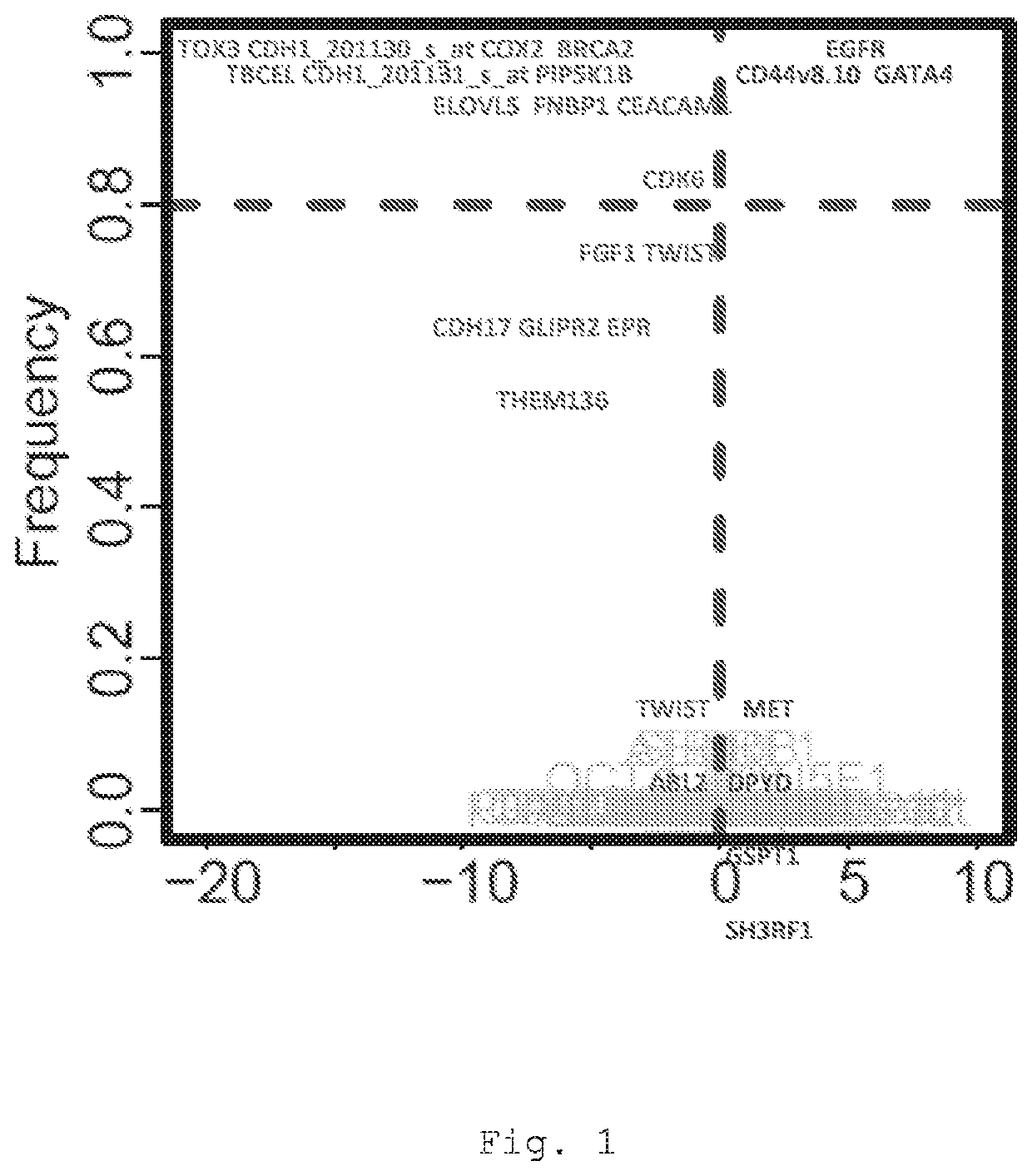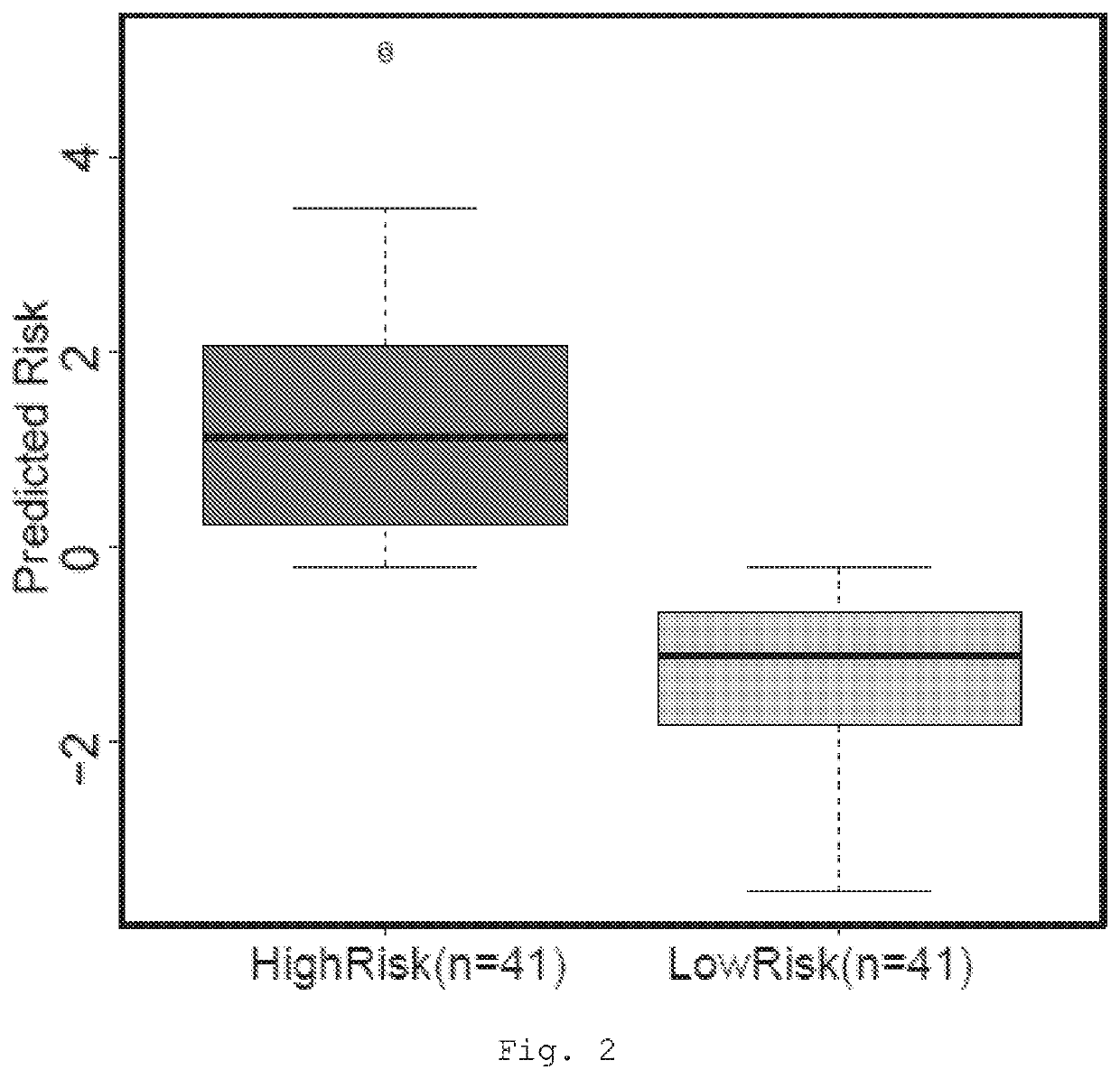Prognostic and treatment response predictive method
a predictive method and treatment technology, applied in the field of prognostic and treatment response prediction methods, can solve the problems of unmet needs for further models, unfavorable chemosensitivity, and disease stage, and achieve the effects of avoiding unnecessary follow-on treatment, aggressive treatment, and high dos
- Summary
- Abstract
- Description
- Claims
- Application Information
AI Technical Summary
Benefits of technology
Problems solved by technology
Method used
Image
Examples
reference example 1
f G-INT / G-DIFF Intrinsic Subtypes
[0187]Five hundred and three patients were randomised to surgery alone or perioperative chemotherapy plus surgery in the MAGIC trial, of which 456 (91%) underwent surgery and had a date available for further analysis. Gene expression data was available for 204 patients who underwent surgery with a date available in the MAGIC trial.
[0188]Two hundred and nineteen patients were characterised, and twenty two technical replicates were performed. However, dates of surgery were only available for 204 of these patients, and therefore only those patients were analysed for survival.
[0189]Using an FDR ratio of <0.05 72 (35.3%) were characterised as G-INT, 69 (33.8%) were characterised as G-DIFF and 63 (30.9%) were classified as ambiguous.
[0190]Therefore, the MAGIC population contains a significant proportion of patients who could not be characterised using the G-INT and G-DIF gene expression signature and NTP algorithm.
[0191]The prognostic effect of subgroup wa...
example 2
n of a New Prognostic Gene Expression Signature
[0194]In view of the lack of statistically significant prognostic or predictive effect of the G-INT and G-DIFF subtypes in the MAGIC dataset (Reference example 1 above), the present inventors wished to perform further analyses using this dataset. In particular, it was considered that it would be helpful to identify patients who are high or low risk for recurrence following chemotherapy and resection for consideration of further treatment or not.
[0195]Accordingly, the NanoString analysis was repeated including normalisation for control and housekeeping genes. Following this a regularised Cox regression approach (see Methods above) was followed which in order to a) identify individual genes which are associated with overall survival in the chemotherapy+surgery treated patients and b) group these genes as a signature in order to identify high and low risk groups of patients based on gene expression only in post-chemotherapy resection speci...
example 3
n of High and Low Risk Groups Using Genes Selected in Cox Regression Models
[0200]The expression levels of the seven genes shown in Table 3 were then used to develop a risk score. The individual risk score for each patient was a product of the expression of each gene multiplied by the hazard ratio associated with that gene in Cox regression. Patients were then dichotomised according to risk score split at the median.
[0201]FIG. 2 demonstrates a box and whisker plots plot with the predicted risk of death for high and low risk groups.
[0202]FIG. 3 demonstrates a Kaplan-Meier curve depicting the survival of the high and low risk group in chemotherapy treated patients. When divided into high risk and low risk groups, median survival was 6.65 years (95% CI 3.51 years—not reached) for the low risk group, and 0.95 years (95% CI 0.70-1.36 years) for the high risk group. This suggests that this signature may have prognostic value in patients treated with chemotherapy who undergo resection.
[0203...
PUM
| Property | Measurement | Unit |
|---|---|---|
| Fraction | aaaaa | aaaaa |
| Time | aaaaa | aaaaa |
| Time | aaaaa | aaaaa |
Abstract
Description
Claims
Application Information
 Login to View More
Login to View More - R&D
- Intellectual Property
- Life Sciences
- Materials
- Tech Scout
- Unparalleled Data Quality
- Higher Quality Content
- 60% Fewer Hallucinations
Browse by: Latest US Patents, China's latest patents, Technical Efficacy Thesaurus, Application Domain, Technology Topic, Popular Technical Reports.
© 2025 PatSnap. All rights reserved.Legal|Privacy policy|Modern Slavery Act Transparency Statement|Sitemap|About US| Contact US: help@patsnap.com



